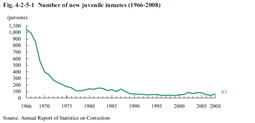| Previous Next Index Image Index Year Selection | |
|
|
1 Status of accommodation and characteristics of new juvenile inmates Fig. 4-2-5-1 shows the number of new inmates younger than 20 at the time of admission (including those who were 20 or older at the time of admission but younger than 20 when they received an indeterminate sentence; hereinafter referred to as “new juvenile inmates”) since 1966.The number exceeded 1,000 in 1966 but then continued decreasing significantly, and has remained below 100 since 1988. In 2008 it was 63 (up 21 from the previous year). Fig. 4-2-5-1 Number of new juvenile inmates (1966–2008) Two juvenile inmates newly admitted in 2008 were females. By age at the time of admission (age at the time they received an indeterminate sentence for those 20 or older when admitted), five were 16 or 17, and 58 were 18 or 19. The amendment of the Juvenile Act in 2000 enabled juveniles younger than 16 sentenced to imprisonment with or without work to serve their sentences at juvenile training schools until reaching 16. However, no one has been subject to this provision up to the end of 2008. Examining the number of new juvenile inmates by term of sentence (maximum term with indeterminate sentences) revealed that two were sentenced to “more than 10 years but 15 years or less,” 24 to “more than 5 years but 10 years or less,” 18 to “more than 3 years but 5 years or less,” 19 to 3 years or less, and none to life imprisonment. By type of sentencing, 59 were sentenced to imprisonment with work and four to imprisonment without work. By type of offense, homicide was the largest in number with 14, followed by injury with 12 (injury five, injury causing death seven), robbery with eight (robbery one, robbery causing death or injury six, rape on the occasion of robbery / rape on the occasion of robbery causing death one), rape / rape causing death or injury with seven, negligence in vehicle driving / negligence in the pursuit of social activities causing death or injury with five, theft with two, and Stimulants Control Act violations with two (Source: Annual Report of Statistics on Correction). |
